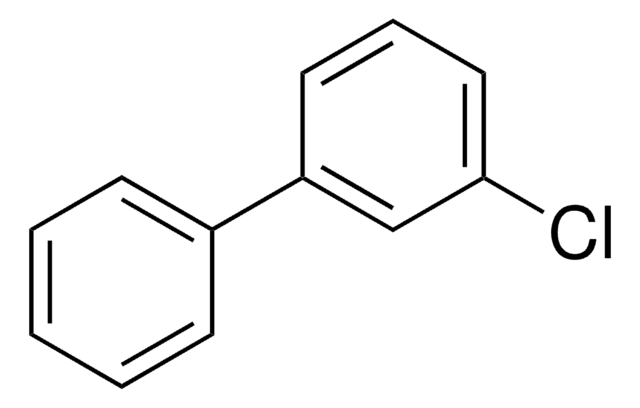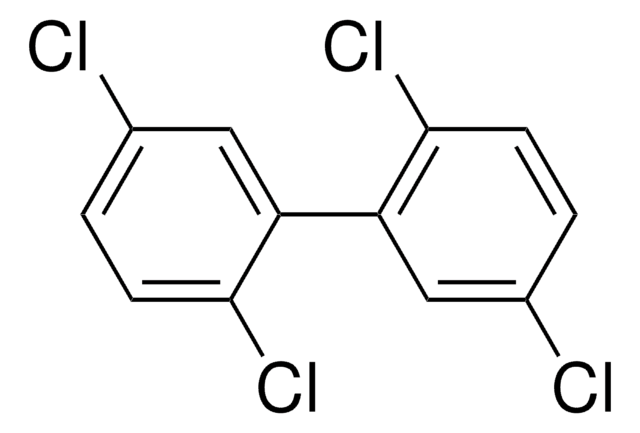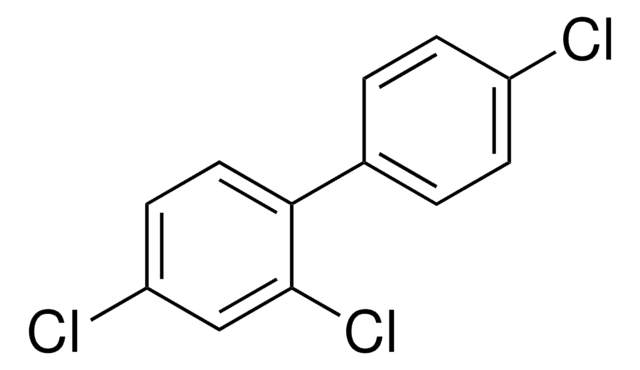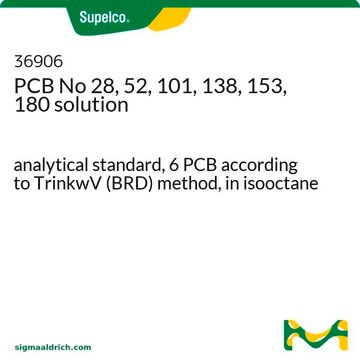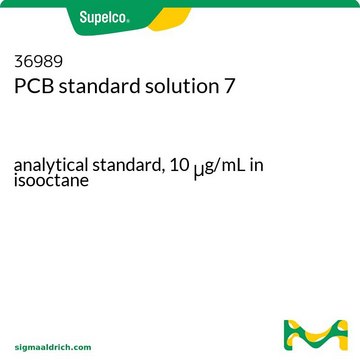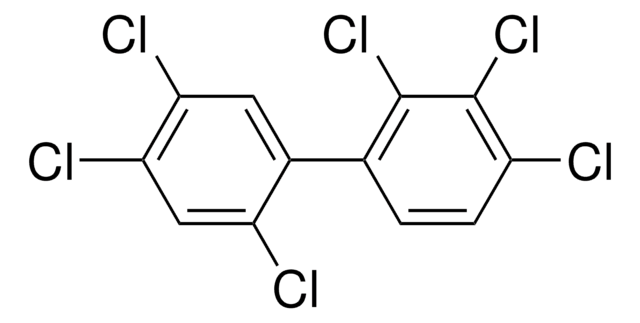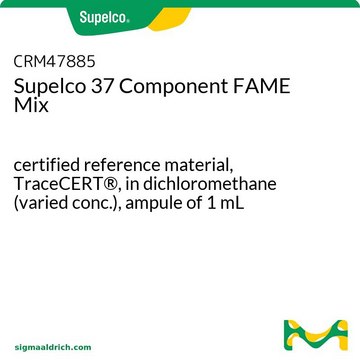おすすめの製品
グレード
analytical standard
シェルフライフ
limited shelf life, expiry date on the label
テクニック
HPLC: suitable
gas chromatography (GC): suitable
アプリケーション
environmental
フォーマット
neat
SMILES記法
Clc1ccc(cc1)-c2ccccc2
InChI
1S/C12H9Cl/c13-12-8-6-11(7-9-12)10-4-2-1-3-5-10/h1-9H
InChI Key
FPWNLURCHDRMHC-UHFFFAOYSA-N
類似した製品をお探しですか? 訪問 製品比較ガイド
詳細
Polychlorinated biphenyls (PCBs) belong to the class of highly toxic pollutants commonly found in various environmental matrices and food products. They find a variety of applications as flame retardants, plasticizers, dielectric and heat transfer fluids, etc.
アプリケーション
PCB No 3 may be used as an analytical reference standard for the quantification of the analyte in aqueous solution in the presence of dissolved organic carbon using high-performance liquid chromatography technique.
Refer to the product′s Certificate of Analysis for more information on a suitable instrument technique. Contact Technical Service for further support.
おすすめ製品
Find a digital Reference Material for this product available on our online platform ChemisTwin® for NMR. You can use this digital equivalent on ChemisTwin® for your sample identity confirmation and compound quantification (with digital external standard). An NMR spectrum of this substance can be viewed and an online comparison against your sample can be performed with a few mouseclicks. Learn more here and start your free trial.
シグナルワード
Warning
危険有害性情報
危険有害性の分類
Aquatic Acute 1 - Aquatic Chronic 1 - STOT RE 2
保管分類コード
11 - Combustible Solids
WGK
WGK 3
引火点(°F)
Not applicable
引火点(℃)
Not applicable
個人用保護具 (PPE)
dust mask type N95 (US), Eyeshields, Gloves
適用法令
試験研究用途を考慮した関連法令を主に挙げております。化学物質以外については、一部の情報のみ提供しています。 製品を安全かつ合法的に使用することは、使用者の義務です。最新情報により修正される場合があります。WEBの反映には時間を要することがあるため、適宜SDSをご参照ください。
PRTR
特定第一種指定化学物質
労働安全衛生法名称等を表示すべき危険物及び有害物
名称等を表示すべき危険物及び有害物
労働安全衛生法名称等を通知すべき危険物及び有害物
名称等を通知すべき危険物及び有害物
Jan Code
35596-BULK:
35596-100MG:
35596-VAR:
最新バージョンのいずれかを選択してください:
この製品を見ている人はこちらもチェック
Anna Ptak et al.
Reproductive toxicology (Elmsford, N.Y.), 20(1), 57-64 (2005-04-06)
Theca interna and granulosa cells from small, medium and large preovulatory porcine follicles were cultured as a monolayer to compare the effects of 4-chlorobiphenyl (PCB3) and its metabolites on estradiol secretion. Cells were treated with PCB3 or its mono- and
Ariane Toussaint et al.
Applied and environmental microbiology, 69(8), 4837-4845 (2003-08-07)
The nucleotide sequence of the biphenyl catabolic transposon Tn4371 has been completed and analyzed. It confirmed that the element has a mosaic structure made of several building blocks. In addition to previously identified genes coding for a tyrosine recombinase related
J A Jacobus et al.
Environment international, 36(8), 970-979 (2010-08-27)
Polychlorinated biphenyls (PCBs) are a class of persistent organic pollutants with myriad biological effects, including carcinogenicity. We present data showing gender-specific genotoxicity in Fischer 344 transgenic BigBlue rodents exposed to 4-chlorobiphenyl (PCB3), a hydroxylated metabolite, and the positive control 3-methylcholanthrene
Anna Ptak et al.
Toxicology letters, 166(3), 200-211 (2006-09-05)
Polychlorinated biphenyl (PCBs) levels of tens and hundreds of pg/ml for individual congeners are measured in human follicular fluid. PCB3 (4-chlorobiphenyl), caused a significant increase in estradiol secretion in porcine granulose-theca cell co-cultures and its two metabolites, 4-OH-PCB3 and 3,4-diOH-PCB3
Kiran Dhakal et al.
Chemical research in toxicology, 25(12), 2796-2804 (2012-11-10)
Polychlorinated biphenyls (PCBs) are legacy pollutants that exert toxicities through various mechanisms. In recent years exposure to PCBs via inhalation has been recognized as a hazard. Those PCBs with lower numbers of chlorine atoms (LC-PCBs) are semivolatile and have been
ライフサイエンス、有機合成、材料科学、クロマトグラフィー、分析など、あらゆる分野の研究に経験のあるメンバーがおります。.
製品に関するお問い合わせはこちら(テクニカルサービス)